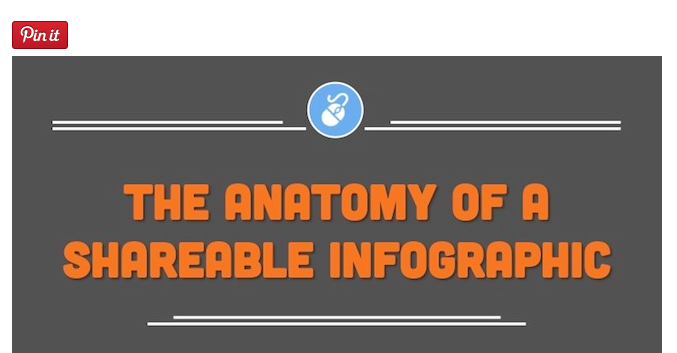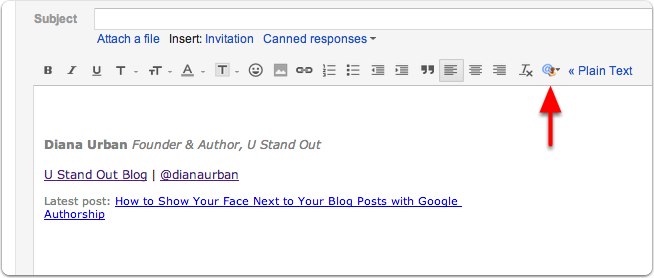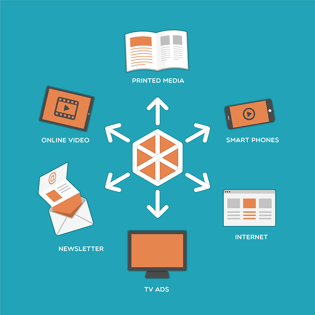Quality isn't the only secret to successful content marketing. While relevant, insightful content will always win, promotion is critical to traffic, engagement, and lead generation metrics
The most successful content marketers are often experts at creative content distribution, and may spend up to four times more time and effort promoting content than creating it. Entrepreneur Renee Warren writes that the success recipe is 20% creation and 80% promotion.
Content Promotion Strategies: Beyond Owned Social Media
If you are promoting your company's blogs and new eBooks to your company's owned social media accounts, that's certainly a good first step. However, there are tons more ways you can use to get your content in front of the right audience. In this blog, you'll learn 31 advanced and intermediate ideas for creative content distribution.
1. Contact Your Sources Directly
If you quote an influencer in your content or use a research firm's data, reach out via Twitter or email. There's a good chance they'll click to ReTweet or promote your content in front of their audience, which can win you massive exposure.

This promotion method takes less than five minutes, and it's really darn effective.
2. Hire Brand Ambassadors
B2C brands are tapped into the potential of brand ambassadors, or everyday people with successful lifestyle blogs and massive social media following. However, this brand can definitely be used in the B2B realm by "boring brands," too.
The best brand ambassador relationships are built carefully. Identify candidates who already have the right audience, and enter into an agreement around content promotion. Reward your ambassadors for their time, effort, and exposure.
3. Prepare Varied Sharing
Every time you publish a new piece of content - blogs, eBooks, content offers and more -- you should take about 15 minutes to prepare for cross-channel promotion. This can include:
- Creating, at least, one custom image for social media sharing
- Pulling out important quotations, stats, and facts
- Identifying potential "tidbits" that can serve as click-enticing promotion headlines
While the content is still fresh in your mind, it's wise to prepare for diverse and sharing multiple times on each of your social media channels. If multiple employees in you company promote your content on social media, these sharing assets make it easy for them, too.
4. Build Relationships with Your Promoters
You know how your happiest customers are already sharing your content? Or how you've won over certain industry fans, who frequently post your new blogs to Twitter or Facebook? These promoters are an asset.
Here's the really important thing. Reciprocity is crucial. If your promoters are in the business of creating custom content, lend them a ReTweet. Add their blogs to your scheduled Tweets and Facebook posts in HubSpot or HootSuite. Reciprocate their efforts to build a lasting relationship.
5. Seek Out Niche Networks
Some industries or regions have super-niche social media networks from which to draw. In some cases, these sites resemble a vertical LinkedIn. Examples of niche networks that could fit your business could include:
If your ideal customers or peers are using niche networks, you should also work to build a presence. Treat it as any other aspect of your social media marketing campaign. Invest time, measure returns and work to build authentic relationships.
6. Put Sharing Opportunities in Your Content
If you're sharing really bright ideas or fresh stats, make it easy for your readers to pass on your content. With smart social integration, you can add opportunities for sharing right into the body of your content. Examples of this can include:
Tweet This Links:

image credit: HubSpot
You, too, can easily generate custom code for click-to-tweet links and buttons on the Twitter website.
Shareable Images:

To build a pin this button like the one in this example from HubSpot, check out the Pinterest Developers page.
7. Use Text Calls to Action
In the body of blogs, insert relevant internal links if they provide value to your readers. When used sparingly and as a non-obtrusive tool, this tactic can increase your crawl rate. See the example below:

8. Create Influencer Roundups
Using social media or HARO, contact industry experts to ask if they'd like to provide input on a fun topic. Co-created blogs or influencer roundups can be a fantastic way to cover trending topics, like "What's Next for Web Design?"
Social Media Examiner is just one of many blogs who frequently compile quotations from industry influencers to create highly shareable, in-depth custom content:

Once your blog goes live, don't forget to follow up with your influencers to encourage content sharing.
9. Use HARO
Help a Reporter Out is a free email list that's sent out 15 times a week -- that's three times a day, five days a week. The list connects subject matter experts with media and other content marketers. Registered users can submit calls for sources or respond to media requests to speak with an expert.
Speaking from personal experience, this resource is an absolute goldmine for content creation and promotion. If you're selected as a source by a media member or marketer, chances are they'll link to your blog or social media. If you use HARO to create a high-quality blog, your expert source may be happy to promote the content.
10. Contact Potential Sources
Chances are, you're already connected with a treasure trove of industry experts via LinkedIn, Email, Facebook, and other channels. If you are writing a blog, why not hesitate to reach out to one or more of your expert friends and ask for a quotation? It's easy, painless, takes five minutes, and has a very low failure rate.
Post-publication, be sure to follow up with your sources with a sincere note of thanks and a link to the blog. Chances are, they'll be eager to promote it.
11. Set Up Google Alerts
If you haven't taken the time to set up Google alerts for your name, company name, or blog name, the time to do this is now. If you're ever linked to or quoted, be sure to show up in the comments and say "thanks." A gracious attitude can go a long way towards earning additional exposure from your fellow content marketers.
12. Reformat Existing Content
Infuse your best-performing content assets with new life by using one or more of the following content repurposing tactics:
- Add a fresh and improved headline
- Upgrade your imagery
- Expand the length or value
By taking steps to improve your content that's already driving traffic from social media and search, you can continue to promote it without redundancy.
13. Create Content Round-Ups
If you are already keeping up on blogs in your industry, start archiving the best new posts each week in Evernote or another tool. Once a week, write a weekly round-up showcasing blogs and content. Strive to include "unsung" heroes in your industry, who work to deliver high-quality content that doesn't have the exposure it deserves. Be sure to contact everyone you spotlight to try and earn some shares.
14. Use Quora
Quora isn't technically a tool for content promotion. In fact, if you begin posting links to your content, there's a good chance you'll be banned from this question-and-answers community. The focus on Quora is on high-quality answers from subject matter experts. Instead, think of Quora as a long-game tool for content promotion. Provide value in the form of thoughtful answers, and you'll build thought leadership and exposure over time.
15. Use Reddit
Reddit is a tricky network, but it's a pretty important tool for promotion that many content marketers overlook. As of January 2016, the site boasted 243 million monthly visitors. If you play your cards right, you could explode the size of your audience. However, the trick to using Reddit correctly is to stop thinking like a marketer and commit to acting like a community member (Redditor). Here are some best practices:
- Join industry subreddits
- Become an active member of that subreddit, by upvoting and commenting on threads
- Submit links to your content to the appropriate subreddit
If your link submissions far outweigh your participation, Reddit is likely to flag you as a spammer. You may not know if you've been flagged -- a common approach to punishing marketers on this network is "ghosting," where your submissions simply aren't visible to other users.
16. Co-Create or Co-Brand
Consider collaborating with other companies on co-created content. Co-branded eBooks, video chat debates, and podcasts can be effective ways to combine your expertise. Perhaps best of all, splitting promotion efforts has the potential to double your exposure.
17. Use Traditional Press Releases
Does your target audience read newspapers, online news, or industry journals?
If the answer is "yes," traditional media promotion methods could be the right choice for you. You could gain exceptional exposure by drafting a press release to announce the publication of original research, high-value editorials, free tools, or whitepapers.
18. Consider Native Advertising
Native advertising isn't technically inbound marketing. But it's not interruption marketing, either. This practice is officially defined as "a form of paid media where the ad experience follows the natural form and function of the user experience." You probably encounter native advertising most often in the form of sponsored content on Forbes, Huffington Post, Buzzfeed, and other websites.
Native Advertising can be a complicated addition to your inbound marketing strategy. There're quite a few factors to consider, including the audience of the site, and your budget. However, native advertorials can be a powerful way to earn exposure, thought leadership, and new audience members.
19. Strive to "Earn" Media
Earned media consists of print and digital mentions that are freely given. Research indicates that consumers trust earned advertisement more than any other form of marketing. Examples of earned media across multiple modern channels could include:
- Profiles or mentions in a business journal
- Coverage by local media
- Winning an industry award
- "Shout-outs" on social media from a satisfied customer
You can't purchase earned media. It occurs organically through building a high-quality brand and reputation. However, you can increase your chances of this occurring naturally by building relationships with media and industry thought leaders.
20. Join Forums
Forums hit their peak in the late 1990's and early 2000's. Many forum users have switched from message boards to social media networks. However, there are still active professional forums, and forum membership is certainly something to consider. While message board activity can vary significantly by industry, three examples of active forums include:
21. Manually Reach Out to Select Promoters
Don't hesitate to occasionally ask your existing promoters for shares. Send an email or quick message via LinkedIn, especially if you publish something in line with their interests. Remember, your promoters could quickly lose their good will towards your brand if you bombard them with content promotion requests. Use this tactic delicately, and balance it with reciprocity or reward.
22. Use Your Email List
In addition to offering blog subscription as an option for your readers, consider earning more subscribers by offering additional options. HubSpot and other content management systems (CMS) and tools allow email subscribers to manage their preferences. Optimally, you should strive to offer the following content digest options:
- Daily/Real-time
- Weekly
- Monthly
23. Build Peer Groups
In addition to LinkedIn groups, there may be demand in your industry for content marketer's peer groups exclusively for the purpose of networking, content exchange, and co-promotion. Kevan Lee of BufferApp reports he's a part of a Slack channel full of marketing bloggers. Depending on how much your niche has adopted content marketing, there may be room to create a private Facebook group or Slack channel for the sole purpose of content co-promotion.
24.Create a Resources Library
Many organizations are beginning to offer a resource or a dedicated website page that features their library of long-form content. This typically includes eBooks, whitepapers, and reports. You can also include in-depth, high-performing articles on this page.
25. Offer "Related Posts" on New Blogs
Using an app, CMS plug-in or manual effort, begin linking to three or four pieces of relevant content at the bottom of each new blog to increase your previous article's exposure.
26. Make it Easy for Employees to Share
If your employees aren't sharing your content marketing to social media, make it your goal to increase internal shares. Inform your colleagues about the thought leadership benefits of becoming an active social media presence in your field.
Make it easy to share by writing a weekly "share this" article with suggested sharing headlines and links to great content. You can even reward your biggest internal promoters by offering a monthly contest for social shares or traffic, with enticing prices.
27. Consider Paid Content Promotion
Paid advertising works extraordinarily well for some organizations, and not-so-well for others. If you've had prior success with pay-per-click (PPC) or other paid digital advertising methods, paid content promotion could be worth experimenting with. Forms of paid content promotion can include:
- Outbrain
- Facebook/Twitter/LinkedIn ads
- PPC
If you choose to use social media advertising for content promotion, take the time to build custom audience groups. Use the job title, demographic characteristics, and company characteristics (firmographics) of your ideal customer to promote your content among the right prospects.
28. Use Email Signature Apps
Invite your marketing and leadership teams to start using an email signature app that links to recent blogs. It's easy to get started using a tool like Wisestamp.

29. Create a Modern Guest Blogging Strategy
Republishing content without modification to other blogs is rarely the right idea. In fact, your website could risk a SEO penalty from Google for duplicate content. However, you can create high-quality, original content on related topics and themes for other blogs in your niche, and win new audience members.
30. Look Local
If your audience is local or your business has a brick-and-mortar location, consider partnering with geo-targeted publications as a contributor. Your local business journal, newspaper, or chamber of commerce newsletter could be actively looking for columnists and contributors.
31. Use LinkedIn Pulse
Using LinkedIn Pulse, a platform for long-form content publication, publish an image, excerpt, and a link to your website to promote high-quality content. Using LinkedIn Pulse to drive website traffic is most effective if you publish original, in-depth content to this channel as well.
Promoting Your Content
Effective content promotion requires creativity, a ton of effort, and a commitment to continually trying new things. Winning new subscribers, leads, and customers requires marketers to, well, think like a marketer. By investing in new and innovative ways to promote your content, you can drastically increase the chances of exceeding your marketing metrics.










